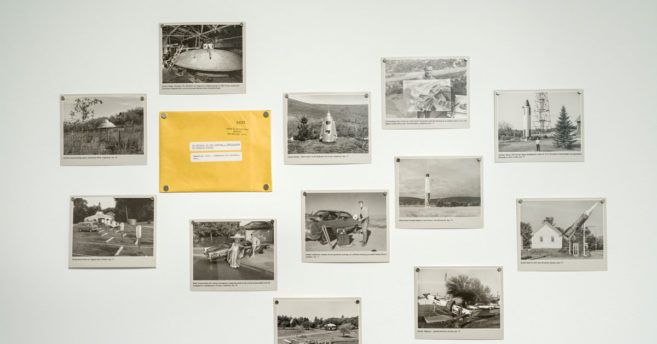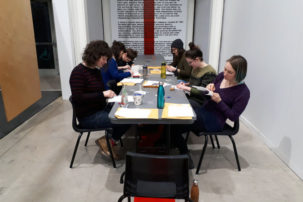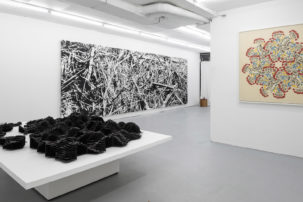Coverings both protect and conceal: shielding from the elements and the harsh judgements of the world, they act as supportive armour that supplements, yet also obscures, our unembellished selves. Coverings imply care and refuge, yet also nudge at the hidden unknown. Charlene Vickers plays with this dual nature in her exhibition “Coverings,” assembling a selection of mixed-media moccasins, paintings and sculptures that reverberate with vibrant colour and a humble, inviting presence.
Knowing Vickers’s power in performance, I can’t help but read her sculptures as carriers of meaningful gestures, and as being performative themselves. While her fall exhibition “Speaking with Hands and Territories” at SFU Galleries focused on audience participation in opposition to the Trans Mountain Pipeline and in relation to unceded Coast Salish territory, “Coverings” is grounded in the quieter reflection of a studio practice, though very much still close to heart and home.
Traces of Ancestral Selves (2014–15), a grouping of handmade moccasin boots, stands together centre-room as if poised to march. Fashioned from cardboard beer boxes and adorned with Ojibwe- and Anishnabe-style beaded flowers, fringed cuffs and patterned fabric, these moccasins turn the “drunken Indian” stereotype inside out. Fragments of legible labels—Old Milwaukee, Kokanee (complete with imagery of unconquered wilderness)—emphasize the appropriation of Indigenous languages and lands within alcohol branding strategies. Yet the care and labour of love in Vickers’s re-appropriation is palpable: from the gathered toes to the intricately embroidered foot beds, she marks those who are absent or displaced, yet there in spirit, transforming the stereotype’s intended sting into a source of pride. Having grown up outside her culture, Vickers has reconnected with her Anishnabe heritage through making these hybrid moccasins since the early 2000s, initially learning through the internet before joining other practitioners. She is also well aware of the ways in which Indigeneity is neatly packaged for consumption in both tourism and art industries. Thus the works’ existence within a commercial gallery conveys a buffered irony, challenging clichés and notions of authenticity with potentially unsympathetic audiences, as if to say: You may or may not care, but I sure do.
Material embodiments sheltering personal narrative echo through two adjacent domestic structures. The House That David Built/Tore Down (2013), a provisional cedar house that acts as both display and storage for her smaller paintings, was named after her adoptive father’s continued renovations of the family home. A painting of a woman sleeping, which marked Vickers’s return to the medium in 2001, is displayed beneath the angled roof. How You See and Cannot See Me At My Window (2018) grapples with private and public selves, keeping the gaze at bay: blind-like slats of modest material—work pants, cardboard beer boxes, mass-produced “Native American”–style blankets and a dangling red performance braid—are stacked inside a wood frame wrapped in bright yellow fabric, obscuring an interior view. The contents communicate abstract ideas of a makeshift self, yet leave much to mystery. “How do you shelter yourself from the way you think people are looking at you?” Vickers asks us, through the piece. Identity is so bound up with personal history, desire, external perception and layers imposed from the world, but these layers can also provide the space to just be, rather than insisting that one constantly view oneself from the outside.
Surrounding the sculptures are Vickers’s vividly rhythmic, psychedelic paintings that energize the space and make the eyes dance. These, too, are documents of experience, influenced by her improvisations with electronic music and the marks she makes in response to moving through the land. Zigzags anchor the paintings in reference to the quillwork embroidery of her ancestors, who symbolically transformed the porcupine’s protective armour into wearable designs. They also organize the composition—a sort of affectionate back-and-forth stitch with nature—into utopic, kaleidoscopic views of the sun, water, sky and sulphur piles of Vickers’s daily commute to and from North Vancouver.
In the back gallery, two groups of moccasins are nestled in an intimate communion that moves across relations and time. Works in The Singles: Performance Moccs Series (2018)—elegantly beaded moccasins made from whisky and beer boxes and placed atop casually scattered cedar “shoeboxes”—are left deliberately incomplete, with the other, imagined half of each pair waiting to be activated by her fellow performer-collaborator, Maria Hupfield. Perhaps they also reference Hupfield and Vickers’s recent performances at Seattle Art Fair and the Western Front, in which they connected past influences to the present and future. In Sleep Walking (2016), a circle of antique domestic chairs cushioned by folded blankets supports a variety of beaded, denim, fur-lined and beer-box moccasins that seem to be in conversation, wrestling with misrepresentations and expressions of “Indianness” in their interior and exteriors. Two black-and-white Edward Curtis–like photographs of Indigenous women stare out from within a pair of blue moccasins whose camouflage pattern is beaded over, like a resilient growth in critique of the portrait subjects’ portrayal. Other letter-beaded pairs impart clues of internal struggles and affirmations against discrimination: “Reclaiming Your spirit / Work Hard” and “Native Woman Seeks Artistic Employment / Paid Less” capture the crossroads of creative work, whereas “Still Indian / Still Nish” grounds and asserts the roots of Vickers’s being. Her homemade and craft aesthetic communicates an honesty without pretension; overall, the exhibition is infused with her expansive concept of “embodied territory”: the idea that wherever she goes, she carries a part of her history and where she is from, regardless of how exteriors attempt to limit or contain identity.
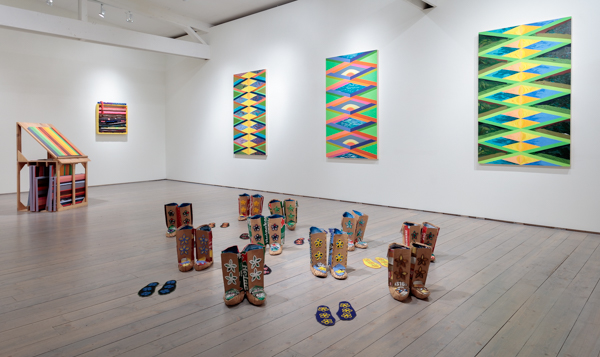
Installation view of Charlene Vickers’s "Coverings," 2018.

Charlene Vickers, Sunken Suns Under Water, 2016. Oil on wood panel, 1.52 m x 76.2 cm.

Installation view of Charlene Vickers’s "Coverings," 2018.

Charlene Vickers, How You See and Cannot See Me At My Window, 2018. Wood, craft felt, camp blankets, work pants, beer cases and cotton fabric, 66 x 62.2 cm.

Charlene Vickers, The Singles: Performance Moccs, 2018. Whiskey case cardboard, beer case cardboard, cotton fabric, glass beads and cedar blocks, dimensions variable.

Charlene Vickers, Singles: Performance Moccs Series, 2018. Beer box, cotton fabric and thread.

Charlene Vickers, Singles: Performance Moccs Series, 2018. Whiskey box, cotton fabric, acrylic beads and thread.

Installation view of Charlene Vickers’s "Coverings," 2018.

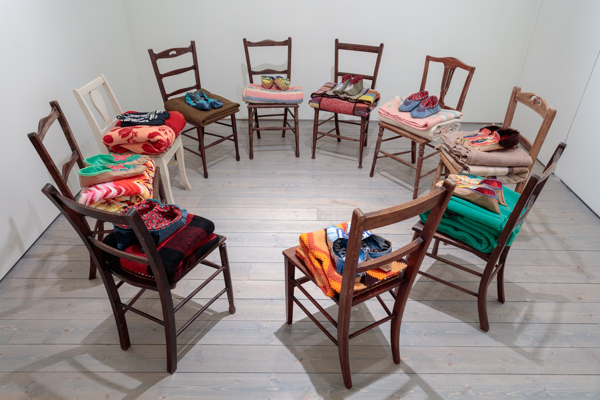 Charlene Vickers, Sleep Walking, 2016. Twelve 1920s bedroom chairs, beer case cardboard, denim, cotton, blankets, glass beads, letter beads and thread, dimensions variable.
Charlene Vickers, Sleep Walking, 2016. Twelve 1920s bedroom chairs, beer case cardboard, denim, cotton, blankets, glass beads, letter beads and thread, dimensions variable.
